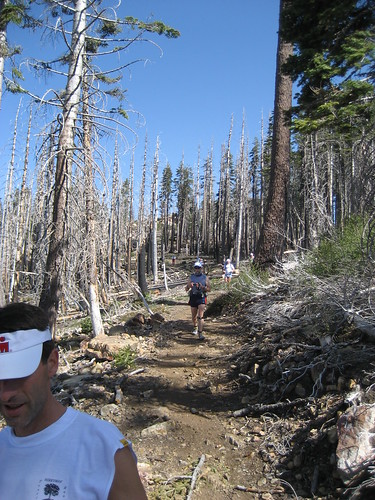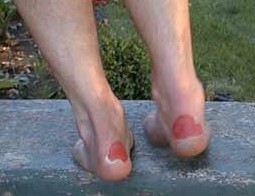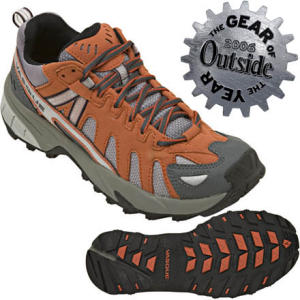Disclaimer: There are some strong opinions expressed here, but most of them were acquired over time by (me) making many stupid mistakes, and learning from those mistakes. Take it or leave it, it's just information (with some personal opinion added). Most of this information applies to trail runners, but much of it crosses-over to regular pavement running, especially for marathoners. Something I don't mention below: some folks have toes that curl upward or severely downward or outward, and they have special issues to deal with, so please forgive me. (That's where pre-lubing or proper taping methods can come-in handy. I don't normally advocate taping).
Trail Running - Preventing Blisters and Black Toenails:
I disagree with runners that think they have to lose toenails and get blisters on every ultrarun or marathon. It's ridiculous. Especially runners that aren't front-runners in races. (The real fast folks are a different level of runner who push the limits constantly, and probably will lose toenails and get blisters because of racing shoe choices, never stopping to adjust anything, etc). But if you are a slow to upper-middle-of-the-pack runner in long races, what I would call an "Extra-Mediocre Runner," blisters and black toenails are very preventable. I haven't had a blister in 3 years and have NEVER lost a toenail...(sound of wood being knocked). And that includes hilly & mountainous ultra races, and more than a few 50 and 100-milers where my feet were wet & muddy for the whole event.
If you get blisters or black toenails every time you run a race...change something...anything, darn-it! On a recent 3-day training run on trails through the Sierra Nevada Mountains in May 2007, my buddy and I didn't have a problem. LOTS of other folks did. On the first day, we ran 34 miles of technical trails in the mountains. We had 3 major (40-minute) steep decents, and 3 major (one-hour) steep climbs throughout the day. Half of the "first day folks" had major problems with feet and leg issues, and most of them dropped out of training camp that first day. It was easy to see what they were doing wrong, in most cases. The "toenail losers," "ankle twisters," and folks that got "stone bruises" were always wearing "normal" road running shoes or racing flats, instead of trail-running shoes. And most of the blister folks didn't have their shoes tied tight enough, or didn't know anything about electrolyte consumption or foot care.
Talking to some of these runners was interesting, (and is what got me so riled-up to post this). Many of them just assumed that it's normal to have massive blistering and other problems, especially while running in the mountains. (Some of them live there, and train on those trails constantly, too). Heck, I don't have mountains here in Kansas City, and I don't have any of their problems when I run in the mountains.

A training run on the Western States 100 Trail, May 2007.
Blisters:
Blisters are caused by 3 causal factors: heat, moisture, and friction. Trying to eliminate all 3 of these from your running experience can be impossible, but you can usually minimize at least one of the factors during a run, and thus prevent blisters.

Gnarly heel blisters on some poor sap.
Socks:
Wearing socks that wick-away moisture is a huge plus. You should never wear cotton socks! They stay saturated and are like wet sandpaper on your feet. Find a synthetic or wool sock or sock combination that works for you (during training). I personally use Injinji Tetrasok (toe-socks) in combination with a very-thin outer sock, like a Bridgedale, Smartwool, or Ultimax (depending on the season/weather). This combination works well for my feet, but you may need something else, entirely. Try out your sock experiments during training...duh! What about not wearing socks at all, you say? Unless you are very special, or actually have your shoes "painted" onto your feet for a super-custom fit, you will just end up being a really-stinky-footed-and-blistered-idiot.

Injinji Tetrasok...the "Toe Sock."
Sizing:
Sizing your shoes is important, because your feet will expand up to 1/2 size during a very long run. I buy shoes that are 1/2 size larger than my feet for ultra-running distances. Your feet (and hands) will also swell if you don't take-in enough electrolytes during a race or long run. Foot swelling can cause blisters. Here's a good article about that:
Blisters, Black Toenails and Sodium by Karl King: http://www.succeedscaps.com/blisters.html
Tying:
Also, tying your shoes correctly or tight enough is very important, especially in hilly or muddy conditions. I use a lacing method (called lace-lock) that prevents heel-slippage on steep up-hills and in muddy, shoe-sucking conditions. On steep down-hills, if your shoe laces are loose, your toe will slam into the front of your shoe and cause major toe and toenail trauma. This is how many folks get dreaded "black toenail" and lose nails after a race. It's also a recipe for severe blistering. Like your mom used to say, "Tie your shoes!"
Proper Shoes:
Wearing shoes "appropriate for the conditions" is paramount. If I run a race on pavement, then I will wear racing flats or other road running shoes. On a rocky and root-infested trail, I always opt for true trail-running shoes. The stone-bruised and ankle-twisted runners at the end of every race are usually wearing road-racing flats or soft, non-protecting road running shoes. Most of them end up with lost toenails, as well, (because the toe-box on these shoes is real tight). Unless you are a really fast & fluid trail runner, or a "World-Class" trail runner, I would not opt for road-running shoes on any trail ultra, trail marathon, or trail race.

Vasque “Blur” Trail Running Shoes
As I've said before:
True trail-running shoes are not just road-running shoes with more durable upper soles and added traction. Trail-running shoes should be fairly light, and have more protection for your toes and forefoot area, to keep from getting "rock & root-induced trauma." You also want your heel to sit lower within the back of the shoe to avoid ankle sprains. Road-running-style "motion control shoes" tend to be higher in the heel area, less flexible, and more prone to putting torque on your ankle area than true trail-running shoes. While wearing these "higher-heeled" shoes, If you were to step on an small stump, rock or root, (which you eventually will), you would have a much higher chance for a severe ankle injury. Not good. Also, the stiffer the shoe, the less of your shoe bottom contacts the surface of the unevenly-surfaced trails. You therefore have less control and less "trail feel" with a stiff shoe. Stiffness also equals heavy, in most cases. There is absolutely no reason why a decent trail-running shoe should be any heavier than a road-running shoe. More information here.
Foot care:
Taking care of your feet during the run is important. I always see ultra-newbies and uber-superstitious runners at races with drop bags "bigger than a bus," filled with shoes and socks to change in to, during the race. This is a very naive tactic, in most cases. In a wet race, your feet will be wet again within minutes. (And now you've just lost 7 or 8 minutes changing shoes/socks at the aid station, all for nothing). A better tactic is to treat your feet when problems arise. When you feel the pain of a "hot spot" forming that will eventually become a blister, pull to the side of the trail and put some lube on the particular spot. Carry a small amount of lube with you. I use a water-resistant and thick silicone gel. You can also use any anti-chafing sports lubes found at running stores. I only pull back the first sock layer, then apply lube directly to the sock surface at the "hot spot" location. It takes me 30 seconds to do this, but it will make all of the difference in the world. Also, in a dusty/sandy race, gaiters can work to keep friction-producing crap out of your shoes. Taking care of your feet BEFORE a run or race is important, also. Trim and file your toenails prior to any long run. This will lessen the chance for toenail trauma.
Proper Training:
Training "for the conditions of the trail" is important. If you train only on pavement for a trail marathon or a trail ultra, you are either a TOTAL MORON, or you are a poor sod that has no "trail options" in your immediate area. For instance, I am always amazed at the number of 100-mile racers that NEVER train on night trail runs, even though up to 40 miles of their 100-mile race will be done at night. Training on trails for events (and on trails at night) teaches your body to "feel" the trail, and to react to trail surface conditions quickly...to "go with the flow" of the trail. It's called "proprioception." You will learn to become a fluid trail-runner that hardly ever trips and rarely falls, if you train this way. This is a good thing, if you intend to race in long-distance trail races, do well, and not fall flat on your face or have other troubles.
In summary, preventing most foot problems is easy:
Tie your shoes. Wear appropriate footwear for the conditions. Wear the proper size of shoe. Never wear cotton socks and find socks that work for you. Take your electrolytes. Take care of your feet immediately when any problems arise. Pick your feet up high enough to clear objects on the trail, (then repeat); this can be practiced while ACTUALLY TRAINING ON TRAILS, (not pavement).
For more running and trail-running advice and information, click here.
Happy trails,
Bad Ben
PS, in the interest of full disclosure:
I have no financial interest in the products mentioned above, but Vasque is a sponsor for our Midwest Trail Series, this year. I personally like to run in Vasque Blurs, but I also like to run in La Sportiva "Pikes Peak" and Mizuno "Trail Wave Ascend 2" models, and a few other shoes, too. Find the shoe/sock combination that is right for you. By the way, I have big, flat (size 13) feet with narrow heels and a wide forefoot
-Bad Ben
This was great. Since my first marathon I haven't lost any toenails but I do suffer from blisters/callouses on my big toes. I have tried different socks, lubes, different shoes, nothing seems to work. I think I must run my big toes literally into the ground or something :) Luckily my blisters are never big enough or painful enough to worry too much about.
ReplyDeleteIn your case, a little pre-lubing on your toes might work.
ReplyDeleteYou have reaffirmed my training and gear choosing. I had blisters in my first trail race where I wore shoes that were too loose (and really did not prepare for properly). I have since switched to ultralight smartwool's and a tighter fitting shoes and have not had an issue since. I love these educational posts, keep em' coming. I'm not 100% on the Psummer Psycho, but Mt. Hood is going to happen. Happy Fathers Day!!
ReplyDeleteThis was a very good post. I am still having problems with blisters. My next try will be lacing my shoes differently.
ReplyDeletegood post. couldn't agree more. i'm nowhere close to being an ultrarunner, but as i prepare for my longest race ever...the golden hills trail marathon in oct. i am learning alot from the ultra runner comunity and applying it to my own training.
ReplyDeletethanks again for a well written and informative post.
Great, informative post. We should all get together and co-author a book on trail running. I know we'd be more informative and beginner friendly than some other publishers or so-called experts namely Rodale Press.
ReplyDeleteI'm bowing to the almighty all knowing BAD BAN. . . great post.
ReplyDeleteGood deal, Ben! Karl and Darcy also talked about tiyng shoes very well, something I avoided so far (for Morton's), but I will train on it next month and see how it goes.
ReplyDeleteHave an awesome time pacing this weekend!!!
Some great advice, thanks for sharing. Some I was painfully aware of, some was new to me.
ReplyDeletehome fitness
Great post Ben. You should send this to Complete Running. It's just the kind of stuff they need!
ReplyDeleteOk, had to stop at the gnarly blisters. I am soooo not ultra material. LOL.
ReplyDeleteGreat post Ben. Just found your site and it's great reading. I agree with you re not changing socks. I laugh when I see runners trying to dance around any puddle in the race even in the pouring rain when they are going to get wet anyway. Splash through and the icy water is nice on your calves.
ReplyDeleteI tend not to suffer blisters too much anyway but I did acquire these in a 145 mile race in the UK
http://www.facebook.com/photo.php?pid=880084&l=a667bec2cc&id=585836915
Tasty.
All the best.
Thank you! You often write very interesting articles. You improved my mood.I'll be back again.
ReplyDeleteAre there meeting points that encourage encounters that lead to the support of ideas and thought leadership?
ReplyDeleteOur mission is to focus the public attention on the problems created by consumption of this product and present positive alternatives that enable positive change.
ReplyDeleteIt will take consumers and businesses coming together and working on many solutions at once to turn the tide on this problem.
ReplyDeleteIts use will be off-limits for ordinary citizens, saving a million dollars a year and reducing greenhouse gas emissions in the region.
ReplyDeleteThe internal structure of the organization highlights the immediate impacts of the means of production in this line of business.
ReplyDeleteWhat do I do when my toenail has blistered underneath and is now loose and flappy.. I have trail shoes, I have great socks and such. What should I do with the toenail?
ReplyDeleteReally good post Ben. The lace-lock is great. And I really like the idea of lubricant between sock layers - it will allow movement to occur between the socks rather than against the skin. I've not heard of anyone doing this. Mari, John Vonhof had more to say on preventing toenail blisters recently: http://www.fixingyourfeet.com/blog/2014/08/1740/
ReplyDeleteAbout 7 years late to this post, but apart from the shoe models mentioned the rest of the information hasn't dated at all.
ReplyDeleteI'd add another tip, though: I spend most of the late spring and summer walking around barefoot. Not in socks, not "barefoot" shoes, just 100% barefoot. This helps toughen up the soles of the feet and has definitely helped with reducing blistering.
I used to be barefoot a lot, back in my martial arts days. My feet were very tough and I built up quite a callous on my foot pads. The only real watch out to this is that if you do get a blister under the callous, it is horrendous...believe me.
ReplyDeleteEducational stream and some courses :-
ReplyDeleteFor somewhat cctv course london occupational it is imperative to kind sure the actions are all successively all respectable. As soon as in attendance are appropriate connoisseur’s help first aid training course london it can be unsurpassed arrangement without pebbledash somewhat flat race. The matching is the occasion where it is going on and attainment the Door Supervisor training london helpfulness of collective people. At this time is the editorial roughly it control & restraint courses london uses as well as points.
Black toenails are likely one of the most common injuries I see in runners in Houston and San Francisco. There can be a couple of causes of black toenails from running.KeriDerm Rx Toenail Fungus Cream Review
ReplyDeleteLooks like I may be losing this bad-boy in a little while. Although it doesn't hurt anymore, it's pretty badly bruised and the nail is awfully brittle. So I did what any clever female runner would do, slap on some darker polish and hope for the best.LCN Canada Mykosept
ReplyDeleteAside from the medications and other forms of treatments, a person should also trim his/her nails regularly for keeping them short and neat. It is also important to dry up feet after every shower to prevent the development of fungus. You also need to use absorbent socks and throw out your old and thrash-like shoes that may be a breeding ground for fungal spores.Nail Bright Nail Fungus Cream Lotion Review
ReplyDeleteThose heels look really bad! I've been trying out a ton of nail fungus solutions recently as I tend to get them really bad. I started blogging about it over at Fix Fungal Nails but will keep you updated.
ReplyDelete